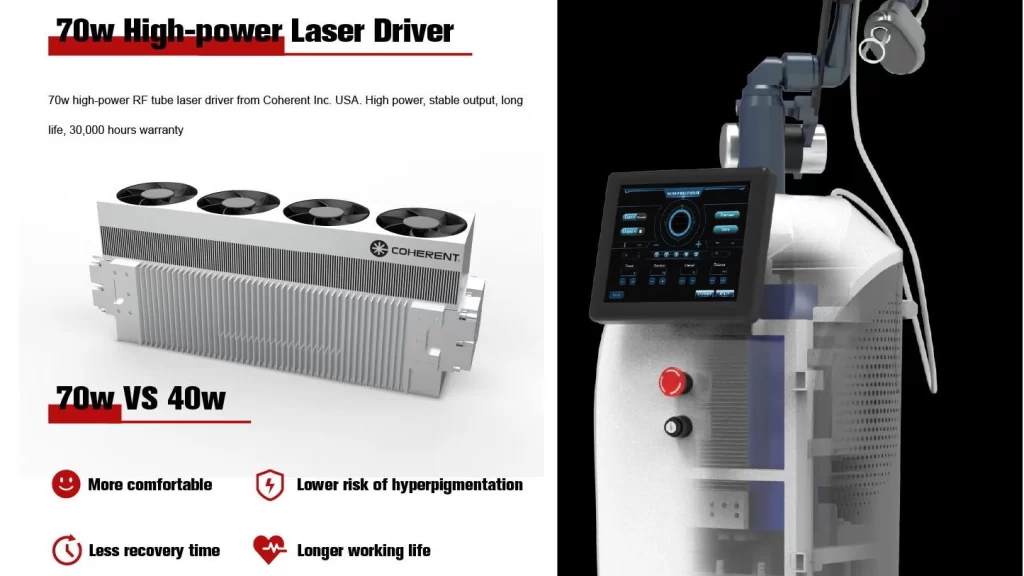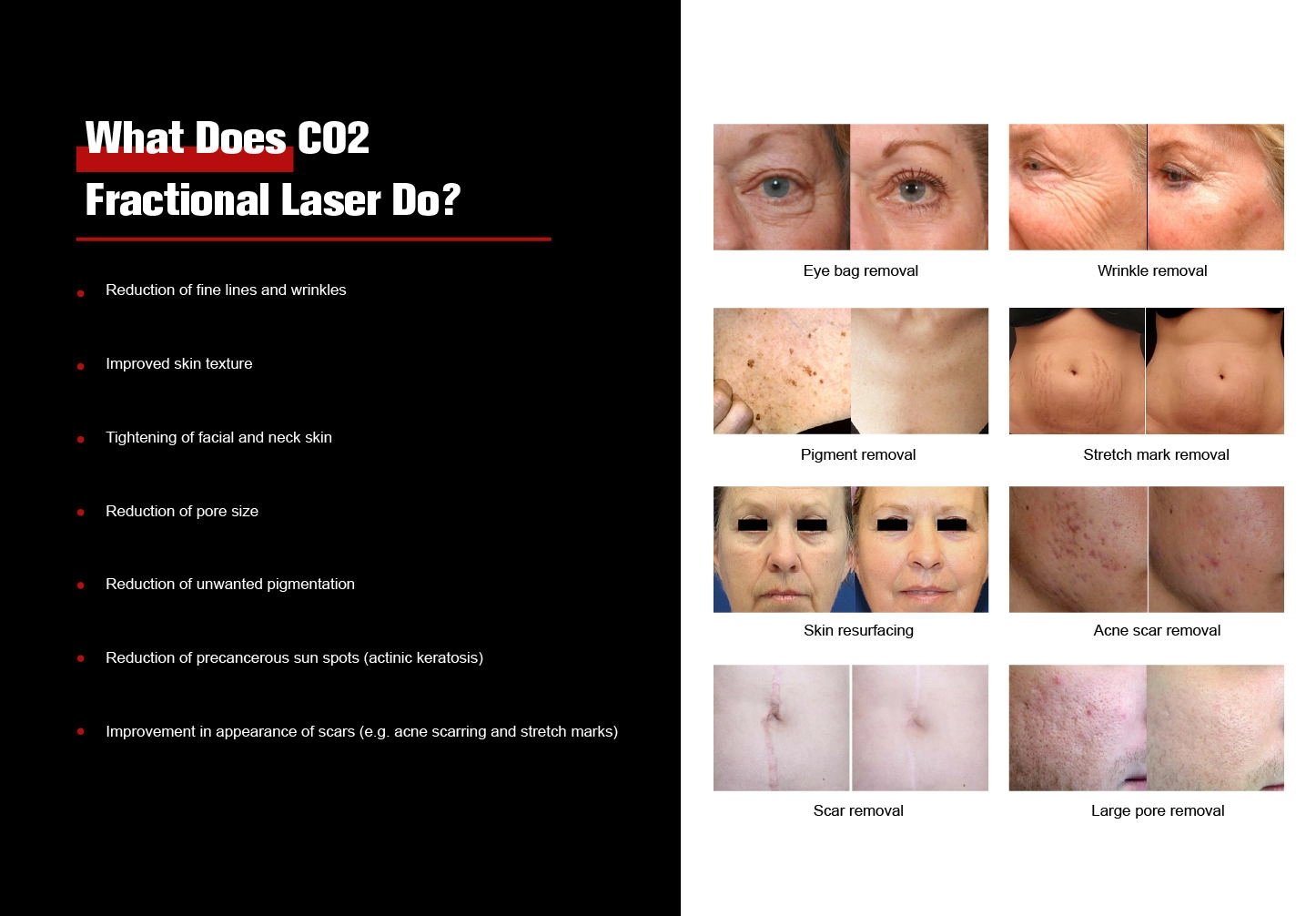Fractional CO2 lasers are a big deal for skin treatments. They help smooth out skin, fade scars, and fight aging signs. But getting great results depends on adjusting the laser to fit your skin type. Things like energy levels and cooling methods matter a lot for safe, awesome outcomes. This guide breaks down how these lasers work with different skin tones to get the best results while keeping risks low.

Why Your Skin Type Matters
What Are Fitzpatrick Skin Types?
The Fitzpatrick scale groups skin into six types based on how it reacts to sunlight. Types I to III are lighter skin that burns easily but doesn’t tan much. Types IV to VI are darker skin that tans well but can get dark spots after treatments like lasers.
Each skin type needs a different approach for fractional CO2 laser treatments. Lighter skin can often take stronger settings. Darker skin needs a softer touch to avoid problems.
Risks for Different Skin Tones
Lighter skin doesn’t often get pigment changes. But it can still get red or need more recovery time if the laser’s too strong. Darker skin has a higher chance of dark spots, scars, or uneven texture because of more melanin. That means treatments need to be extra careful.
Why Checking Your Skin First Is Key
Before starting, a good check-up is a must. Doctors look at your skin type, health history, past treatments, and what skincare you use. This helps them set the laser just right to keep risks low and results great.
Adjusting Laser Settings for Your Skin
Settings for Lighter Skin (Types I–III)
Energy and Pattern Choices
Lighter skin can handle higher energy and denser laser patterns. There’s less worry about pigment issues. For stuff like wrinkles or scars, doctors might crank up the settings to get big changes.
Getting Results with Less Downtime
Even for lighter skin, recovery time is important. Using fractional modes leaves some skin untouched to help it heal faster. Cooling during treatment keeps redness and discomfort down.
Settings for Darker Skin (Types IV–VI)
Keeping Dark Spots and Scars Away
For darker skin, use lower energy and less dense patterns. This cuts down on heat damage. It lowers the chance of dark spots from stirred-up melanin.
Acne scars are lasting marks from bad acne breakouts, leaving bumpy skin or discoloration. These are common in darker skin, so gentle, focused treatments are key.
Cooling and Aftercare Needs
Cooling during treatment protects your skin from too much heat. The inside of the handle is equipped with a special temperature sensing system, controlled by software and backed by the machine’s strong cooling system. It can get as cold as -30°C. This keeps you comfy and helps stop swelling, which prevents dark spots in darker skin.
Keeping Things Safe in Clinics
Spotting Risks and Dealbreakers
Before any laser treatment, check for issues like active infections, recent sun exposure, or meds that make skin sensitive. People with thick scars or immune problems might need extra care or to skip treatment.
Talking Straight with Patients
Chatting with patients about risks, results, how many sessions they’ll need, and recovery time builds trust. Showing before-and-after photos helps them know what’s realistic.
Why Skilled Operators Matter
Lasers need someone who knows what they’re doing. Our products are R&D by professionals, designed with your customers in mind. Built with top-notch tech, these machines need trained operators who get the tech and how it works on skin. Good training keeps things safe for all skin types.
Making Results Last with Aftercare
Right-After-Treatment Care for All Skin Types
Cooling, Moisturizing, and Sun Protection
Aftercare starts as soon as the treatment’s done. Cold packs ease swelling. Soothing creams keep skin hydrated. Daily sunscreen is a must to avoid pigment changes while healing.
The treatment is comfortable and completely painless. This comfort sticks around during recovery if you follow aftercare steps carefully.
Long-Term Skin Care
Skincare to Help Healing
Use gentle cleansers and serums like vitamin C. Retinoids can help when it’s time. Keep up with sunscreen. Regular check-ins with your doctor let them tweak your routine for better results.
Only clean pores can ensure definite nutrition absorption. Deep nutrition delivery is important. This helps your skin repair and build collagen during recovery.

Fractional CO2 lasers service can do amazing things for any skin type when the settings are just right. Whether adjusting energy or using cool features like Nubway’s machines—with a 30000+ ㎡ factory and 50+ R&D engineers—safety and great results go together.
Clinics looking for solid tools should check out Nubway’s fractional CO2 laser systems. They’re made for performance and safety. Our products have been exported to over 120 countries, trusted worldwide with CE, FDA, ISO13485 certifications, and 24/7 support from trained engineers.
For practices wanting awesome skin solutions for every skin tone, Nubway’s fractional CO2 laser equipment is a choice you can trust.
FAQ
Q: What is a fractional CO2 laser? How does it work?
A: A fractional CO2 laser is a skin treatment. It uses a carbon dioxide laser beam. This beam makes precise tiny wounds in the skin. The wounds form a grid pattern. This action triggers your body’s collagen production. It also encourages new skin growth. Importantly, the laser leaves the skin around each tiny wound untouched. This means healing is much faster than with older laser methods.
Q: How do doctors adjust fractional CO2 laser settings for different people?
A: The laser operator changes the settings for each patient. They look at things like skin type (using the Fitzpatrick Scale I–VI). They also consider skin thickness, how sensitive the skin is, and the specific skin issue being fixed. Settings include energy power, how long the laser pulse lasts, and how close together the tiny wounds are. People with lighter skin might handle stronger energy levels. People with darker skin usually need gentler settings. This helps avoid problems like darker patches or burns.





